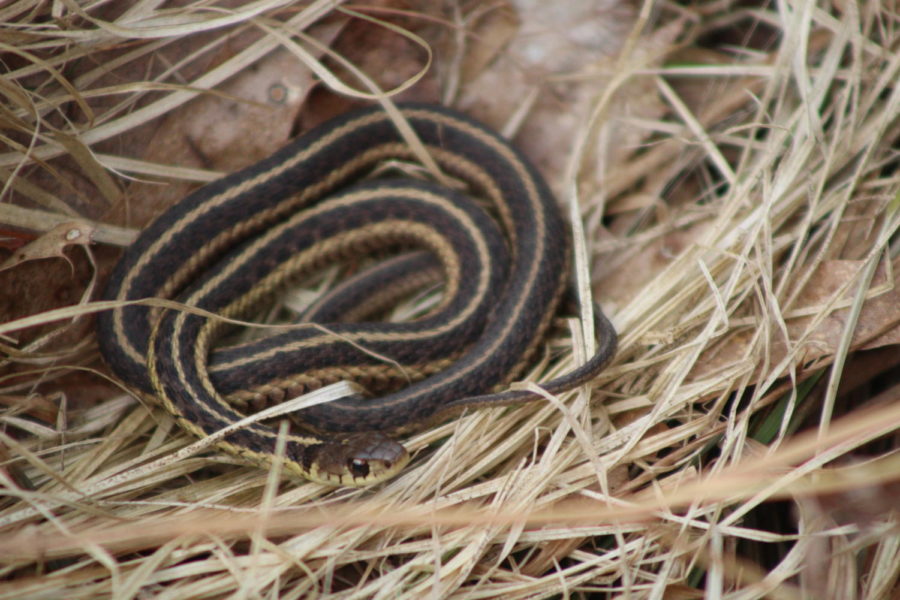Notes from a Naturalist: April
Nights are becoming full of sound as frogs start to call this time of year. These chatty amphibians are starting to make their characteristic sounds this time of year to find mates and establish territories. You can tell the species of frogs apart by the sounds they make. Perhaps the most famous, Spring Peepers are aptly named. They make high-pitched peeps that blend into a cacophony during the spring and summer. Peepers are the smallest frogs in Massachusetts, they are only about 1.5 inches long. The next two smallest frogs are Gray Treefrogs and Wood Frogs. Gray Treefrogs can be either green or gray, they can change their color based on their habitat. Their call is a trill that is occasionally mistaken for birds. Wood Frogs make a duck-like quack. The Pickerel and Leopard Frogs look similar and have similar calls. They both sound like snorts, but the Pickerel Frog’s call is shorter than the Leopard Frog’s. Green Frogs can be 4 inches long and are the second largest frog in Massachusetts. Their call is a single, loose note that sounds like a banjo. Bullfrogs are the largest frog at 8 inches long and have a distinctively deep call. Their call sounds like a tuba and often has three tones to it. Keep an ear out for the calls of these amicable amphibians!
Look out for April’s full moon on the 16th. This month’s full moon has several names such as the Fish Moon, Hare Moon, or Pink Moon.
Some slithery and scaly residents of Massachusetts are starting to wake up this time of year. Garter Snakes are one of the most common snakes in our area. They have yellow and black stripes down the length of their bodies. These snakes can be seen in almost any habitat, even in your own backyard! They are adaptable and eat a variety of other organisms including invertebrates, amphibians, and even small mammals. During the winter, Garter Snakes gather in underground burrows. These dens can be old woodchuck burrows, crevices in hills, caves, or even house foundations. The snakes can accumulate to groups with hundreds of snakes, though fewer are more common. In the early spring, snakes are often seen around the dens they spent the winter in. Keep an eye out for these super cool snakes, they will be slithering about now!
The 22nd is a busy day for nature. It is Earth Day and the day the Lyrid Meteor shower is expected to peak. Take a peek at the night sky to the northeast and you just might see a meteor. The meteors will be radiating out from the sky near the constellation Lyra. Meteors are pieces of debris that enter the Earth’s atmosphere and burn up. It is the light from this combustion that makes the little flashes of light we see from the ground as meteors.
We have all seen birds flying, but birds have to stop flying at some point – they can’t fly forever. There is a bird that takes their flying to the limit, only stopping during the nesting season. This bird is the Chimney Swift, an amazingly aerial bird. They are using their flying skills to come back from their wintering grounds this time of year. Chimney Swifts can eat, drink, sleep, and even bathe while flying. Chimney Swifts are so adapted to a life on the wing that they can’t perch sitting up like other birds. The only way they can perch is on vertical surfaces such as caves or chimneys, as their name suggests. They make their nests out of grasses and sticks and use their saliva to adhere it to the wall of the cage or chimney the birds are nesting in. Keep an eye out for these incredible birds, they often look like flying cigars (an oval-shaped body with little wings). They’ll be arriving back from their wintering grounds in South America soon!
As the natural world starts to green up this time of year, some wildflowers are already blooming. Many of these plants, such as Bloodroot, Hepatica, Mayflower, and Yellow Trout-Lily, are found in wooded areas. Bloodroot has small, white flowers with one flower per stem. The flowers are close to the ground and have a large leaf below each stem. There are two species of hepatica in New England, Round-Lobed Hepatica and Sharp-Lobed Hepatica. These plants can have purple, pink, or white flowers and leaves only at the base of the stems. The leaves of Hepaticas are present year-round which allows hepatica to be one of the first flowers to bloom in the spring. Mayflowers (also called Trailing Arbutus) is the state flower of Massachusetts and has small, pink flowers. The plant is low to the ground and is often pollinated by queen bumblebees. Yellow Trout-Lilies have downward-facing yellow flowers and the plants are often found in colonies. They generally have two large leaves at the base of the stem. Keep an eye out for these colorful hints of spring!


